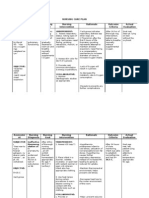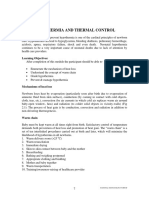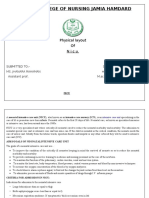NCP Hypothermia
NCP Hypothermia
Uploaded by
xchardxCopyright:
Available Formats
NCP Hypothermia
NCP Hypothermia
Uploaded by
xchardxOriginal Title
Copyright
Available Formats
Share this document
Did you find this document useful?
Is this content inappropriate?
Copyright:
Available Formats
NCP Hypothermia
NCP Hypothermia
Uploaded by
xchardxCopyright:
Available Formats
PALAWAN STATE UNIVERSITY COLLEGE OF NURSING AND HEALTH SCIENCES Puerto Princesa City
NURSING CARE PLAN
CUES
Nursing Diagnosis
Risk for hypothermia related to immaturity of newborn s temperature regulatory system as manifested by: y T-36.2 C y Newborn Exposure to cool environment y Not fully develop thermoregulati on y Conduction y Evaporation y Convection y radiation
Rationale
Newborn convection Radiation Conduction (The skin is not fully develop until 29 weeks of age)
Objective
After 8 hours of nursing interventions the SN will be able to:
Expected Outcome
Nursing Interventions
Rationale
.
Evaluation
After 8 hours of nsg.interventions the objective were completely met as evedinced by: K-Reported signs and symptoms seen and manifested by the baby such as: -T 36.2 C -Free from any complications.
y y
T-36.2 C Newborn Exposure to cool environment Not fully develop thermoregulati on
conduction (their warm body heat transfers to cooler objects that they come into direct contact with) evaporation from exposure of wet skin surfaces lost to
Evaporation
Conduction T-36 4C Risk for hypothermia
K-Identify the signs and symptoms of hypothermia such as: (a) Peripheral vasoconstriction -Acrocyanosis -Cool extremities -Decreased peripheral perfusion (b) CNS depression -Lethargy -Bradycardia -Apnea -Poor feeding (c) Increased
K-SN will identify and report atleast 10 signs and symptoms of hypothermia such as: (a) Peripheral vasoconstriction -cool extremities -decreased peripheral perfusion (b) CNS depression -Bradycardia -Apnea (c) Increased metabolism -Hypoxia
K-Discuss the signs and symptoms of hypothermia
K-To assess and recognize the signs and symptoms of hypothermia
the atmosphere convection (their body heats transfers to the air surrounding them) radiation (their warm body heat transfers to cooler objects around them)
related to to immaturity of newborn s temperature regulatory system
metabolism -Hypoglycemia -Hypoxia -Metabolic acidosis (d) Increase of pulmonary artery pressure -Distress -Tachypnea (e) Chronic signs -Weight loss, poor weight gain S-Demonstrate or show the Unang Yakap Program
-Metabolic acidosis (d) Increase of pulmonary artery pressure -Distress -Tachypnea (e) Chronic signs -Weight loss - poor weight gain
S-Perform the procedure immediately.
S-Provide -Immediate and thorough drying to stimulate breathing after delivery of the baby -Provision of appropriate thermal care through mother - newborn skin-to skin contact -maintaining a delivery room temperature of 25-28 degrees centigrade
S-To prevent further decreased in body temperature. -to restore normal temperature or organ function. -skin to skin contact is the best method to rewarming the baby until the temperature reaches the mormal range. -Balance among heat production,heat
S-Displayed temperature within normal range. T 37.2 C -Stabilized and maintained newborn s temperature.
- wrapping the newborn with clean, dry cloth -place knitcap on infant s head -place droplight or under radiant warmer
gain,and heat loss.
-Heat loss in newborn is greatest through head and by evaporation and convection. A-To promote wellness. -For the continuity of care. A-The procedure was done correctly and effectively.
A-Correctly maintain the positive participation in every procedure.
A-Maintain and update the Unang Yakap Program and other related factors about hypothermia and its ways of prevention.
A-Review and perform correctly the Unang Yakap Program and other related factors about hypothermia and its ways of prevention.
Name of Student: NEEZI E. NATIVIDAD,SN IV
References:PRENTICE HALL NANDA 8TH EDITION, BY: JUDITH M. WILKINSON,PhD,ARNP
You might also like
- Nursing Care Plan Ineffective ThermoregulationDocument3 pagesNursing Care Plan Ineffective Thermoregulationrjalavazo198979% (71)
- Newborn Nursing Care Plan With ReferncesDocument6 pagesNewborn Nursing Care Plan With Referncesneuronurse92% (63)
- NCP NewbornDocument21 pagesNCP NewbornGil Aswigui81% (27)
- Ineffective Airway Clearance NewbornDocument2 pagesIneffective Airway Clearance NewbornHanna Hodge100% (5)
- Nursing Care Plan For A Premature InfantDocument3 pagesNursing Care Plan For A Premature InfantVillablanca Michelle85% (104)
- Neonatal Intensive Care Unit (Nicu)Document30 pagesNeonatal Intensive Care Unit (Nicu)Uday Kumar100% (18)
- Client Care Plan: Assessment/Nursing Dx. Outcome Identification/Planning Implementation EvaluationDocument2 pagesClient Care Plan: Assessment/Nursing Dx. Outcome Identification/Planning Implementation EvaluationTiese Lopez79% (14)
- Child - Bronchiolitis NCPDocument2 pagesChild - Bronchiolitis NCPjoeti80% (5)
- NCP For RDSDocument3 pagesNCP For RDSKevin P. Feliciano74% (23)
- NCP Anxiety PretermDocument1 pageNCP Anxiety Pretermanreilegarde89% (9)
- NCP BreastfeedingDocument3 pagesNCP BreastfeedingLeo FrivaldoNo ratings yet
- Nursing Care Plan Postpartum HemorrhageDocument2 pagesNursing Care Plan Postpartum Hemorrhagederic100% (60)
- SET UP niCUDocument16 pagesSET UP niCUMeena Koushal100% (4)
- Nursing Care Plan JaundiceDocument2 pagesNursing Care Plan Jaundicepapadaad86% (35)
- Prioritize NCPDocument19 pagesPrioritize NCPzey young94% (35)
- Nursing Care Plan Ineffective Infant Feeding PatternDocument3 pagesNursing Care Plan Ineffective Infant Feeding PatternMarife Lipana Reyes100% (1)
- NCP (Hyperbilirubinemia) IIDocument4 pagesNCP (Hyperbilirubinemia) IIbluewipes67% (3)
- LP5-first StepDocument1 pageLP5-first StepMark Arryson CasisonNo ratings yet
- Neonatal Sepsis (NCP)Document10 pagesNeonatal Sepsis (NCP)Lucero Hyacinth100% (1)
- Nursing Care Plan. LyksDocument3 pagesNursing Care Plan. LyksKiyla92No ratings yet
- NB Nursing DiagnosisDocument2 pagesNB Nursing Diagnosisnursingmvd92% (13)
- NCP Ineffective ThermoregulationDocument4 pagesNCP Ineffective ThermoregulationCharmae Navea100% (1)
- NCP NewbornDocument4 pagesNCP NewbornDarren CariñoNo ratings yet
- Nursing Care Plan Ineffective ThermoregulationDocument2 pagesNursing Care Plan Ineffective ThermoregulationLoraNo ratings yet
- Nursing Diagnosis Rationale Goals/ Objectives Nursing Interventions Rationale EvaluationDocument20 pagesNursing Diagnosis Rationale Goals/ Objectives Nursing Interventions Rationale EvaluationElaine Grace Timbol-Babasa100% (1)
- NCP InfectionDocument2 pagesNCP InfectionAngie Dino100% (2)
- NCP NewbornDocument2 pagesNCP Newbornsonylynne94% (17)
- NCP For NewbornDocument2 pagesNCP For NewbornErica Veluz LuyunNo ratings yet
- NCP Altered Thermoregulation HypothermiaDocument2 pagesNCP Altered Thermoregulation HypothermiaMaila Joy Pring Fuentes100% (10)
- Risk For Hypothermia of New BornDocument2 pagesRisk For Hypothermia of New BornjenspryNo ratings yet
- Neonatal Sepsis NCPDocument9 pagesNeonatal Sepsis NCPHollan Galicia100% (1)
- NCP - Hyperbilirubinemia - Staff NursingDocument3 pagesNCP - Hyperbilirubinemia - Staff NursingnurseM67% (3)
- NCP NewbornDocument8 pagesNCP Newbornsupacalifragirlistic67% (9)
- NCP Risk For Impaired Skin Integrity Related To Ongoing Phototherapy Secondary To Increased Bilirubin LevelsDocument2 pagesNCP Risk For Impaired Skin Integrity Related To Ongoing Phototherapy Secondary To Increased Bilirubin LevelsIrish Bantolo100% (1)
- Newborn Nursing CareplanDocument7 pagesNewborn Nursing CareplanSamantha MillerNo ratings yet
- NCP FeverDocument1 pageNCP FeverLuis Romnic Vinuya100% (2)
- Care Plan Redo For NeonateDocument2 pagesCare Plan Redo For NeonateIris Lopez100% (6)
- NCP Altered Skin ColorDocument2 pagesNCP Altered Skin ColorJessa Lyn100% (1)
- Nursing Care Plan of The NewbornDocument5 pagesNursing Care Plan of The Newbornappleliciouz0860% (10)
- Nursing Care Plan Neonatal SepsisDocument2 pagesNursing Care Plan Neonatal Sepsisderic100% (21)
- NCP MeningitisDocument6 pagesNCP MeningitisSkyerex80% (5)
- NCP Risk For InjuryDocument3 pagesNCP Risk For InjuryBianca Freya Porral86% (7)
- Nicu NCPDocument2 pagesNicu NCPYette Polillo Conde100% (1)
- NCP HyperthermiaDocument3 pagesNCP HyperthermiaPrincess Alane MorenoNo ratings yet
- NCP For Parent and ChildDocument3 pagesNCP For Parent and ChildEric Evangelista100% (1)
- Newborn Warming STDDocument69 pagesNewborn Warming STDAlana CaballeroNo ratings yet
- HypothermiaDocument5 pagesHypothermiaMRS CHAKRAPANINo ratings yet
- Neonatal Intensive Care Unit NicuDocument21 pagesNeonatal Intensive Care Unit NicuRadha SriNo ratings yet
- Radiant Warmer - Docx 33Document4 pagesRadiant Warmer - Docx 33Merwan KemalNo ratings yet
- Project OverviewDocument7 pagesProject OverviewMayur KadamNo ratings yet
- Project OverviewDocument7 pagesProject OverviewMayur KadamNo ratings yet
- Resusitasi, Stabilisasi Dan Transportasi DR Rosi 2019Document27 pagesResusitasi, Stabilisasi Dan Transportasi DR Rosi 2019Laura LauraNo ratings yet
- Servo Control Infant IncubatorDocument7 pagesServo Control Infant IncubatorAlfredo Forton PeñaNo ratings yet
- Physiology of Thermoregulation in The NeonateDocument35 pagesPhysiology of Thermoregulation in The NeonateAgung Fuad FathurochmanNo ratings yet
- Warm Chain in Newborn BabyDocument4 pagesWarm Chain in Newborn Babynathsujitkr1980No ratings yet
- Sept 22 Neonatal HypothermiaDocument23 pagesSept 22 Neonatal Hypothermiaf.abrahamNo ratings yet
- Child Health Clinical PresentationDocument4 pagesChild Health Clinical Presentationgourimsc1No ratings yet
- Case Scenario 6Document8 pagesCase Scenario 6Micah YapNo ratings yet
- Nicu Physical LayoutDocument16 pagesNicu Physical LayoutMeena Koushal100% (5)
- Neutral Thermal Neonate SuhuDocument7 pagesNeutral Thermal Neonate SuhudickyaririsandyNo ratings yet



























































